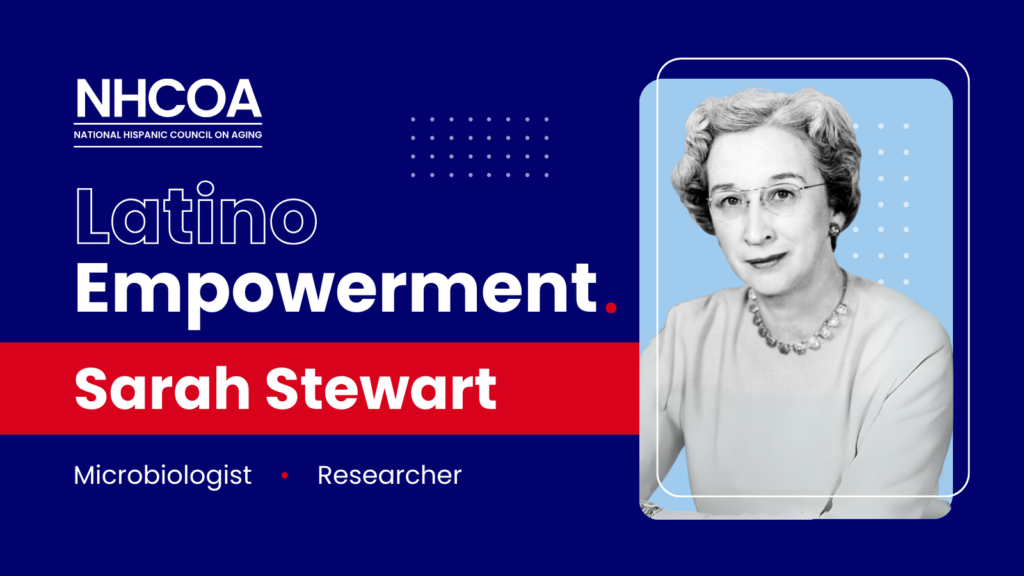
Dr. Sarah Elizabeth Stewart was a Mexican-American researcher who was a pioneer in the field of viral oncology research. She was born on August 16, 1905 in Tecalitlán, Jalisco, Mexico. Her mother was Mexican and her father an American engineer. They had to move back to the United States at the age of 5 due to the Mexican Revolution, as the Mexican government ordered them to leave the country. Despite this, she would continue to speak Spanish fluently throughout her life.
She did her undergraduate work at New Mexico State University and graduated with a Bachelor of Science degree in 1927. She then earned a master’s degree from the University of Massachusetts Amherst in 1930. In 1935, she began working at the National Institutes of Health (NIH), completing a Ph.D. in microbiology from the University of Chicago in 1939. During her time there, she participated in the development of a vaccine for gangrene, which helped many soldiers during World War II.
In 1944, NIH executives rejected Stewart’s proposal to study the link between animal tumors and viruses. She subsequently resigned from the NIH and came to Georgetown University as a faculty member, teaching microbiology in the School of Medicine. She was encouraged to complete her Ph.D. and, in 1949, became the first woman to earn an M.D. from the Georgetown University School of Medicine.
She was the first to successfully prove, using Koch’s hypothesis, that cancer-causing viruses can spread from one animal to another. She and Bernice Eddy co-discovered the first polyoma virus. It was not until 1958 that Stewart and Eddy succeeded in developing the virus that now carries their names, the polyomavirus SE (Stewart-Eddy). This experiment and its results, among other similar experiments, led many researchers to become interested in the field of viral oncology.
As a result of their work, Stewart and Eddy were nominated twice for the Nobel Prize. In 1965, President Lyndon B. Johnson presented Stewart with the Federal Women’s Award for her contributions to the field of cancer research. In 1971, Dr. Stewart returned to Georgetown as a regular professor to teach in the Department of Pathology. Shortly thereafter, she retired to New Smyrna Beach, Florida, where, on November 27, 1976, she died of lung cancer.
Pursuing her goals proved difficult for her for several reasons. First, in 1944, women were still not allowed to enroll as tenured students in most American medical schools, usually pushed to be in the gynecology department, and Sarah was no exception. However, Stewart found a solution: she accepted a position at Georgetown University School of Medicine as an instructor of bacteriology, which allowed her to take medical courses for free. In 1947, the medical school began accepting women, and she formally enrolled. In 1949, at the age of 43, Stewart became the first woman to earn a medical degree at Georgetown.
In addition, her goal was to prove that there was a connection between cancers and viruses. At the time, the two fields of cancer and virus research were thought to be completely unrelated. On the other hand, it was believed at the time that virologists were not qualified enough to participate in cancer research and microbiologists were overqualified to do so. Despite these obstacles, she continued her research and made valuable discoveries in these fields. She even helped identify other viruses in her lifetime, such as herpes, Burkitt’s and those known as type C viruses.
Stewart and Eddy’s work was instrumental in the development of the Human Papillomavirus (HPV) vaccine. This vaccine would never have existed without the research of these two scientists. Their work opened up entirely new lines of research, not only that viruses can cause cancer, but everything that has to do with cancer, including the search for oncogenic viruses in humans. For the rest of her career, Stewart would devote her time to discovering the viruses that contribute to human cancers. In his last article, published in 1972, she reported on possible traces of a virus in a human sarcoma.
When Stewart entered the field, virus research was not on the radar of the National Cancer Institute. In 1960, the NCI was spending $3.9 million a year investigating the connections Stewart discovered, according to the Wall Street Journal. Today, the NIH has a $185 million budget for cancer prevention, which includes virus and cancer research. While Stewart did not live to see the Gardasil vaccine (HPV vaccine) and other triumphs her work produced, she did live long enough to see her field move from the fringes of science to the public interest.
References:
https://www.cancer.gov/research/annual-plan/2023-annual-plan-budget-proposal.pdf

Recent Comments